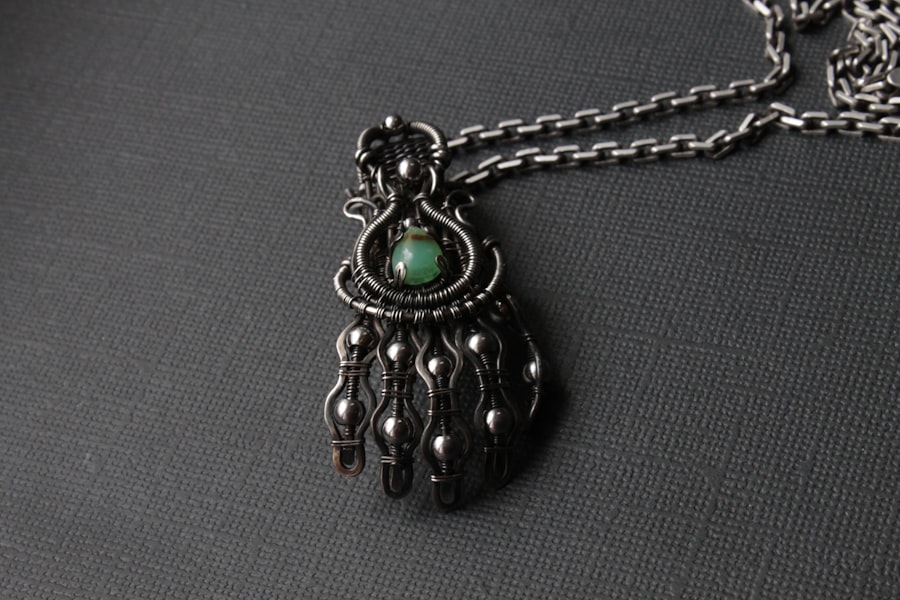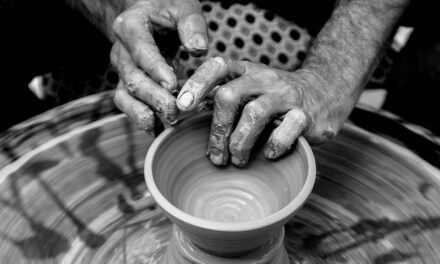Plique-à-jour, a French term meaning “letting in daylight,” is a unique enamelling technique that has captivated artisans and collectors alike for centuries. Its origins can be traced back to the Byzantine Empire, where early forms of enamelling were employed to create intricate designs on religious artefacts. However, it was during the Middle Ages that the technique began to evolve significantly, particularly in the context of ecclesiastical art.
The use of translucent enamel allowed for the creation of stunning stained glass-like effects, which were highly sought after for church decorations and liturgical items. The technique saw a resurgence during the Art Nouveau movement in the late 19th and early 20th centuries. Artists such as René Lalique and other French jewellers embraced plique-à-jour, pushing the boundaries of traditional enamelling.
They experimented with organic forms and natural motifs, creating pieces that not only showcased the beauty of the enamel but also highlighted the interplay of light and colour. This period marked a significant turning point, as plique-à-jour transitioned from a mere decorative technique to a respected art form in its own right, paving the way for contemporary interpretations.
Summary
- Plique-à-jour enameling dates back to the Byzantine Empire and became popular during the Art Nouveau period in the late 19th century.
- Materials and tools needed for plique-à-jour enameling include fine silver or gold wire, transparent enamel powders, a kiln, and various shaping and polishing tools.
- The process of creating plique-à-jour enamel artwork involves creating a metal framework, filling it with enamel, and firing it in a kiln multiple times to achieve the desired effect.
- Techniques for achieving different effects in plique-à-jour enameling include using different colours of enamel, layering the enamel, and using different firing temperatures.
- Common themes and motifs in plique-à-jour enamel art include nature, animals, and intricate geometric patterns.
- Famous artists and artworks in plique-à-jour enameling include René Lalique and his stunning jewelry and decorative objects.
- Care and maintenance of plique-à-jour enamel artwork involves gentle cleaning with a soft cloth and avoiding exposure to harsh chemicals or extreme temperatures.
- The future of plique-à-jour enameling in contemporary art is bright, with many artists exploring new techniques and pushing the boundaries of this traditional art form.
Materials and Tools Needed for Plique-à-jour Enameling
Creating plique-à-jour enamel artwork requires a specific set of materials and tools that are essential for achieving the desired results. The primary material is, of course, enamel itself, which is made from finely ground glass that is fused to metal through heat. The choice of enamel is crucial; transparent and translucent enamels are preferred for plique-à-jour as they allow light to pass through, creating the characteristic luminous effect.
Various colours can be layered to achieve depth and complexity in the final piece. In addition to enamel, artisans need a metal framework to support the enamel. Traditionally, fine metals such as silver or gold are used due to their malleability and resistance to tarnishing.
The framework must be meticulously crafted to create cells or compartments that will hold the enamel. Tools such as a torch for firing, a kiln for controlled heating, and various hand tools for shaping and finishing the metal are also necessary. A soldering iron may be employed to join metal components securely, while fine brushes and spatulas assist in applying the enamel precisely.
The Process of Creating Plique-à-jour Enamel Artwork

The process of creating plique-à-jour enamel artwork is intricate and requires a high level of skill and patience. It begins with designing the piece, where artists often sketch their ideas before transferring them onto metal. The metal framework is then constructed, typically using techniques such as soldering or welding to create a series of cells that will hold the enamel.
This framework must be robust enough to withstand the firing process while remaining delicate enough to showcase the beauty of the enamel. Once the framework is complete, the artist prepares the enamel by grinding it into a fine powder and mixing it with water to create a paste. This paste is then carefully applied into the cells of the metal framework using fine brushes or spatulas.
The piece is then subjected to high temperatures in a kiln, allowing the enamel to fuse and become glass-like. This firing process may need to be repeated several times, with artists often layering different colours to achieve depth and vibrancy. After cooling, any excess enamel is ground away, revealing the intricate design and allowing light to filter through, creating the enchanting plique-à-jour effect.
Techniques for Achieving Different Effects in Plique-à-jour Enameling
Artisans employ various techniques to achieve distinct effects in plique-à-jour enameling, each contributing to the overall aesthetic of the piece. One common method is layering different colours of enamel to create gradients or transitions that mimic natural phenomena such as sunsets or ocean waves. By carefully controlling the thickness of each layer and the firing temperature, artists can produce subtle shifts in colour that enhance the visual impact of their work.
Another technique involves using opalescent or iridescent enamels that change colour depending on the angle of light. This can add an additional layer of complexity to a piece, making it dynamic and engaging from multiple viewpoints. Additionally, some artisans incorporate textures into their designs by manipulating the surface of the metal framework before applying enamel.
Techniques such as hammering or etching can create patterns that interact with light in unique ways, further enhancing the overall effect of plique-à-jour artwork.
Common Themes and Motifs in Plique-à-jour Enamel Art
Plique-à-jour enamel art often draws inspiration from nature, with common themes including floral designs, fauna, and landscapes. The organic forms found in nature lend themselves beautifully to this technique, allowing artists to capture intricate details and vibrant colours that reflect the beauty of their surroundings. For instance, many pieces feature delicate flowers with translucent petals that seem to glow when illuminated from behind.
In addition to natural motifs, plique-à-jour artists frequently explore abstract designs that play with geometric shapes and patterns. These compositions can evoke a sense of movement or rhythm, drawing viewers into a visual dialogue with the artwork. Cultural influences also play a significant role; motifs from various traditions can be seen in plique-à-jour pieces, reflecting a rich tapestry of artistic heritage that transcends geographical boundaries.
Famous Artists and Artworks in Plique-à-jour Enameling

Throughout history, several artists have made significant contributions to the field of plique-à-jour enameling, elevating it to an esteemed art form. René Lalique stands out as one of the most prominent figures associated with this technique during the Art Nouveau period. His innovative designs often featured intricate floral patterns and natural forms that showcased his mastery of colour and light.
One notable work is his “Dragonfly” brooch, which exemplifies his ability to blend functionality with artistic expression. Another influential artist is Peter Carl Fabergé, renowned for his exquisite Fabergé eggs that often incorporated plique-à-jour elements. These luxurious creations not only served as decorative objects but also symbolised wealth and status among Russian nobility.
Fabergé’s use of translucent enamels allowed for stunning visual effects that captivated collectors worldwide. His legacy continues to inspire contemporary artisans who seek to push the boundaries of plique-à-jour enameling.
Care and Maintenance of Plique-à-jour Enamel Artwork
Caring for plique-à-jour enamel artwork requires attention to detail to preserve its beauty over time. Due to its delicate nature, it is essential to handle these pieces with care, avoiding any rough treatment that could lead to chipping or cracking of the enamel. When cleaning plique-à-jour items, it is advisable to use a soft cloth slightly dampened with water; harsh chemicals or abrasive materials should be strictly avoided as they can damage both the enamel and metal components.
Storage is another critical aspect of maintenance; plique-à-jour pieces should be kept in a protective case or padded box when not on display. This helps prevent scratches or accidental impacts that could compromise their integrity. Additionally, regular inspections for signs of wear or damage are recommended; if any issues are detected, consulting a professional conservator experienced in enamelling techniques can ensure proper restoration without compromising the artwork’s value.
The Future of Plique-à-jour Enameling in Contemporary Art
As contemporary art continues to evolve, so too does the practice of plique-à-jour enameling. Modern artists are increasingly experimenting with this ancient technique, incorporating it into diverse mediums such as sculpture, jewellery design, and even architectural elements. The fusion of traditional craftsmanship with contemporary themes allows for innovative expressions that resonate with today’s audiences while honouring historical practices.
Moreover, advancements in technology have opened new avenues for exploration within plique-à-jour enameling. Digital design tools enable artists to conceptualise intricate patterns with precision before translating them into physical forms. This intersection of technology and traditional craftsmanship not only enhances creative possibilities but also attracts a new generation of artisans eager to explore this captivating medium.
As interest in sustainable practices grows, there is also potential for plique-à-jour artists to utilise eco-friendly materials and methods, ensuring that this beautiful art form continues to thrive in an ever-changing artistic landscape.
If you are intrigued by the meticulous and vibrant art of Plique-à-jour enameling, you might also find the exploration of different art movements equally fascinating. A recommended read would be An Introduction to Impressionism, which delves into another revolutionary art technique that emerged in the 19th century. This article provides a comprehensive overview of Impressionism, highlighting its unique approach to capturing light and everyday scenes, which marked a significant departure from traditional art norms of the time.




